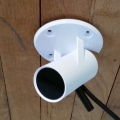Please note: the forum is closed.
No new user registrations are accepted. For more info, please click here.
No new user registrations are accepted. For more info, please click here.
Killed it. Help :(
 Richy_T
Posts: 142🌟 Super Member 🌟
Richy_T
Posts: 142🌟 Super Member 🌟
I had left some PLA in the printer for about a week while I wasn't using it and it had cracked in a few places. I was having trouble getting it out so I pulled the bowden tube out at both ends and was able to remove the filament easily enough. I had the printer running since I wanted the hot-end hot. As I was stuffing the bowden tube and wired back into the cable management, I heard a pop and now no more 3D printer 
I've tried turning it off for a while but no luck. The top fan on the hot-end comes on (which is always running I think) but nothing else. I have some rough ideas where to start looking but could really do with some help.
Thanks.
I've tried turning it off for a while but no luck. The top fan on the hot-end comes on (which is always running I think) but nothing else. I have some rough ideas where to start looking but could really do with some help.
Thanks.
Comments
Current thought is that it was the second fan and that I somehow grounded the wire. I'll definitely have to check that before everything goes back together. Especially if I end up buying another board.
The only way I'd be able to connect from a computer would be if the board was getting 5V from the USB port (which does happen). It's looking like a short which probably means a mosfet. I'll be doing more debugging in the next couple of days.
So not really sure. I'll try each of the connectors and make sure there's a resistance there and not a short to ground. Then when I get the new board, I'll plug in one connector at a time so if it does pop again, at least I should have some kind of a clue. I'll probably add a bit of kapton on the top rim where the wires come out just on the off-chance.
There's always the small chance it was just an unlikely coincidence. I'm not really buying that though.
My immediate aim has been to ensure that whatever killed the old board does not kill the new so I have been going though the connections checking for continuity and that there were no unexpected groundings. Upon testing the hot-end thermistor, I found infinite resistance with no ground issues. Upon removing the thermistor, it was apparent that it had undergone total failure with the wires no longer connected and just some metal blobs at the end.
This thermistor is one that I had to replace sometime last year. While trying to resolve some nozzle issues, the thermistor became damaged. I ordered an OEM replacement but was able to source some thermistors without the lead but with the same spec that arrived more quickly. I was able to use the old lead with a new thermistor and believed (and still do) that I had an item of similar quality to the original. However, it seems that while I was trying to fix my filament issues, some part of the thermistor came in contact with a grounded part, causing my problems and killing the board.
My concern is that something like this could happen again. The hot end, as far as I'm aware, provides no insulation inside the thermistor hole so potentially a bit of movement could cause a repeat of the situation. I'll take a close look at the thermistor to try and be sure there is no exposed metal. It seems like some kind of insulation would be in order?
Howdy, Stranger!
RegisterIt looks like you've been lurking for a while.
If you register, we will remember what you have read and notify you about new comments. You will also be able to participate in discussions.
So if you'd like to get involved, register for an account, it'll only take you a minute!